Low-background and label-free loop-mediated isothermal amplification for rapid detection of foodborne pathogens using amplicon-templated copper nanoclusters
IF 5.7
2区 化学
Q1 CHEMISTRY, ANALYTICAL
引用次数: 0
Abstract
Background
Loop-mediated isothermal amplification (LAMP) is a simple, low-cost, and instrument-free assay, which is highly adaptable for the detection of foodborne pathogens. However, current methods have a high background, making it difficult to achieve sensitive on-site detection.
Results
Herein, LAMP-CuNCs assay with a low background signal was established. LAMP amplicons were used as the templates for the synthesis of copper nanoclusters (CuNCs), and LAMP results were determined by the fluorescence intensity of the amplicons-CuNCs. The stability of LAMP amplicons templated CuNCs was improved by the addition of 1.5 g/mL fructose, which effectively prolonged the fluorescence lifetime. The detection limit of Salmonella DNA was 756 pg/μL, and the sensitivity and specificity of this method were 12/12 and 12/12, respectively. This method could detect Salmonella at a minimum concentration of 1910 CFU/mL in spiked salmon samples.
Significance
The study provided a method that can quickly obtain results within 16 min for detection of genomic DNA and visual inspection under a 365 nm UV flashlight. In addition, this method could also be used to detect Listeria monocytogenes, Vibrio parahaemolyticus, and Escherichia coli.

利用扩增子模板铜纳米团簇快速检测食源性病原体的低背景和无标记环介导等温扩增
背景环介导的等温扩增(LAMP)是一种简单、低成本、无仪器的检测方法,适用于食源性病原体的检测。然而,目前的方法具有较高的背景,难以实现灵敏的现场检测。结果建立了低背景信号的LAMP-CuNCs检测方法。以LAMP扩增子为模板合成铜纳米团簇(cu纳米团簇),并通过扩增子- cu纳米团簇的荧光强度来确定LAMP结果。加入1.5 g/mL果糖可提高LAMP扩增子模板化CuNCs的稳定性,有效延长荧光寿命。该方法对沙门氏菌DNA的检出限为756 pg/μL,灵敏度和特异性分别为12/12和12/12。该方法可在加标鲑鱼样品中检测出最低浓度为1910 CFU/mL的沙门氏菌。意义:本研究提供了一种在365 nm紫外手电筒下可在16 min内快速获得基因组DNA检测结果的方法。此外,该方法还可用于检测单核增生李斯特菌、副溶血性弧菌和大肠杆菌。
本文章由计算机程序翻译,如有差异,请以英文原文为准。
求助全文
约1分钟内获得全文
求助全文
来源期刊

Analytica Chimica Acta
化学-分析化学
CiteScore
10.40
自引率
6.50%
发文量
1081
审稿时长
38 days
期刊介绍:
Analytica Chimica Acta has an open access mirror journal Analytica Chimica Acta: X, sharing the same aims and scope, editorial team, submission system and rigorous peer review.
Analytica Chimica Acta provides a forum for the rapid publication of original research, and critical, comprehensive reviews dealing with all aspects of fundamental and applied modern analytical chemistry. The journal welcomes the submission of research papers which report studies concerning the development of new and significant analytical methodologies. In determining the suitability of submitted articles for publication, particular scrutiny will be placed on the degree of novelty and impact of the research and the extent to which it adds to the existing body of knowledge in analytical chemistry.
 求助内容:
求助内容: 应助结果提醒方式:
应助结果提醒方式:


